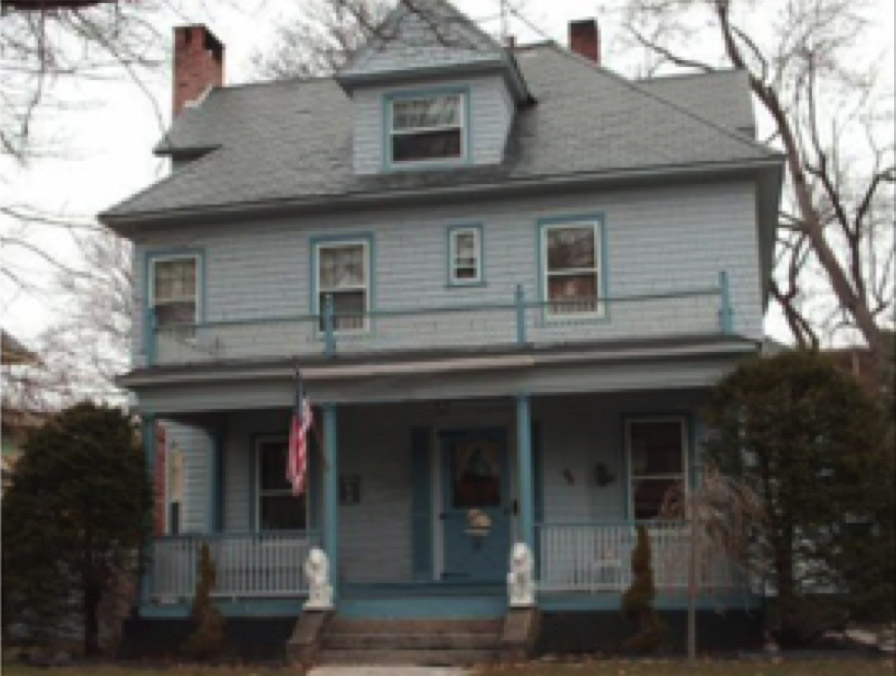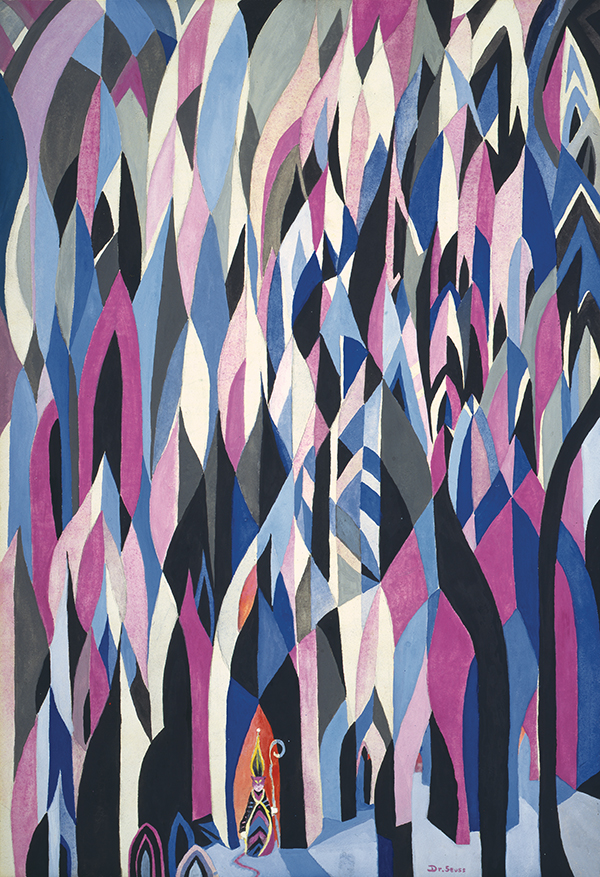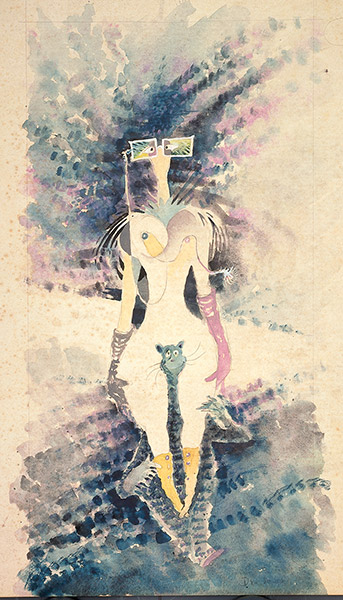Frame not included.
Simply scroll through the page or click one of the links below to learn about this artwork.
Each limited edition print will be accompanied by an 8" x 10" glossy photograph of the above 1969 photograph of Theodor Seuss Geisel at his drawing table with the original That Winter Spring Came Late.
In this 1969 photo of Dr. Seuss, we find an extraordinary secret art painting resting behind his drawing table at his La Jolla home studio.
The home at the center of Seuss’s Secret Art painting, That Winter Spring Came Late, bears what seems to be an interesting resemblance to Dr. Seuss’s childhood home, the very place where he began to synthesize his childhood experiences into his now famous settings and creatures. It is fitting then that in this photo his most recognized character, The Cat in the Hat, rests gently against this nostalgic painting.
Childhood Home
Everyone’s childhood home is full of the family memories and emotional foundations upon which we build our lives. This was especially true for children born just after the turn of the last century. Ted Geisel (aka Dr. Seuss) grew up in an era during which not only major life events—births, weddings, deaths—all occurred at home, but families often remained in the same house for generations. In That Winter Spring Came Late, we find a painting that seems reminiscent of two Geisel family homes, that of Ted’s childhood, as well as his grandfather’s home just a few blocks away, both situated in Springfield, Massachusetts.
The following subtle, compositional elements offer clues to suggest the home in this painting may have been influenced by these two formidable family homes:
- The golden blanket of color that circles the entire house may be reminiscent of the yellow forsythia that bloomed in the Geisel backyard each spring,
- Ted talked often about going everywhere on his bike, including Forest Park and its Zoo, which was only a few blocks away. In the painting, we find a bike stored at the ready under the front porch.
- Electrification had become commonplace around 1900 when the Fairfield home was built and seen here in the painting are electric poles reminiscent of that time.
- And though you have to really look for them, there appears to be echoes of the white lion statues that stood outside the entrance to Ted’s childhood home.
- Finally, in a quintessential Secret Art gesture, Ted places one of his unmistakable cats resting on the sill of the third floor window.
Artwork and Details
Mixed-Media Pigment Print on Canvas, 36" x 24" with additional canvas border
Limited Edition of 850 Arabic Numbers, 99 Patrons' Collection, 155 Collaborators' Proofs and 5 Hors d'Commerce.
Secret Cats
That Winter Spring Came Late joins an acclaimed group of Secret Cats from Ted Geisel’s extraordinarily personal collection of midnight paintings. Cats have taken center stage as a recurring theme in many of Ted’s most important and most sought-after artworks. Like a window into his soul, these works provide a behind-the-scenes look at Seuss the man and the artist. Some cats appear as bold portraits, while in the case of these works, the mostly hidden cats take supporting roles that cleverly punctuate or decode Dr. Seuss as the creator of these images. Ted’s Secret Cats are the ultimate expression of his personality, humor, and artistic inventiveness secreted within his most personal creations.
More on the Springfield Connection
Dr. Seuss’s grandfather, Theodor R. Geisel, Sr. immigrated to Springfield, Massachusetts in 1867, he was 27 years old. In 1876, he pooled savings with Christian Kalmbach to open a small brewery. Ted’s father was born in the quarters beside the brewery on June 28, 1879. The Kalmbach and Geisel Brewery grew to one of the largest in New England, allowing Grandfather Geisel to buy the impressive house at 162 Sumner Avenue in 1901. Geisels would live in that home for the next sixty years.
Sumner Avenue was a red-brick boulevard of Victorian homes. Ted would describe his grandfather’s house as a “white mansion tiered like a wedding cake.” Springfield newspapers reported on family weddings taking place there, as well as large holiday and social gatherings, including operatic musicales featuring New York performers who were friends of the Geisels.
When it came time for Ted’s father to settle his family in their own home, he purchased 74 Fairfield Street. Ted’s immediate family would live in that house from 1906 to 1946, establishing it not solely as Dr. Seuss’s childhood home, but as the house which sheltered forty years of significant familial memories for this incredibly productive artist and author.
















